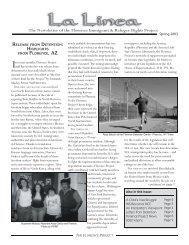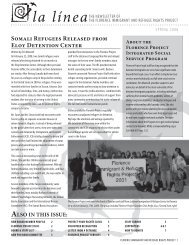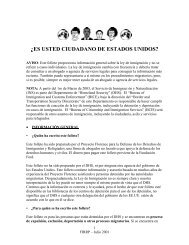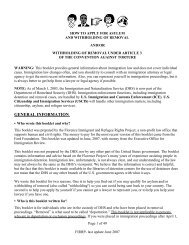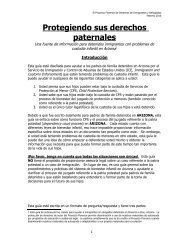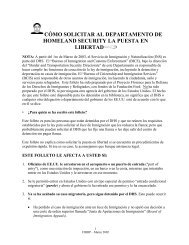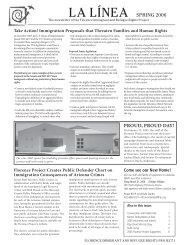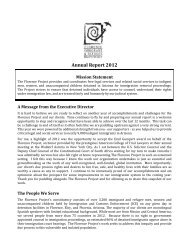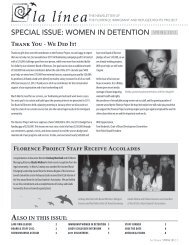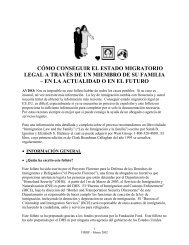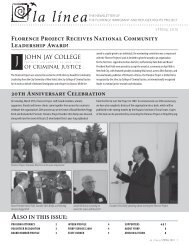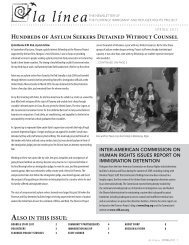quick reference chart and annotations for determining immigration ...
quick reference chart and annotations for determining immigration ...
quick reference chart and annotations for determining immigration ...
Create successful ePaper yourself
Turn your PDF publications into a flip-book with our unique Google optimized e-Paper software.
Immigrant Legal Resource Center, Florence Immigrant <strong>and</strong> Refugee Rights Project,<br />
Maricopa County Public Defender August 2012<br />
3. Paying less than the purchase price of the goods by some trick or artifice such as altering, removing,<br />
substituting or otherwise disfiguring any label, price tag or marking; or<br />
4. Transferring the goods from one container to another; or<br />
5. Concealment.<br />
B. A person is presumed to have the necessary culpable mental state pursuant to subsection A of this<br />
section if the person does either of the following:<br />
1. Knowingly conceals on himself or another person unpurchased merch<strong>and</strong>ise of any mercantile<br />
establishment while within the mercantile establishment.<br />
2. Uses an artifice, instrument, container, device or other article to facilitate the shoplifting.<br />
Shoplifting is a class 5 felony if the value was $2,000 or more, if undertaken during a “continuing<br />
criminal episode,” or if done to assist a criminal street gang or syndicate. Shoplifting is a class 6 felony if<br />
the value was $1000 or more but less than $2000, <strong>and</strong> a class 1 misdemeanor if property is less than<br />
$1000, except <strong>for</strong> a firearm. Certain priors can make it a class 4 felony.<br />
Summary: Theft is a better means of avoiding an aggravated felony with a year’s sentence.<br />
Crime Involving Moral Turpitude (CMT): Shoplifting is a CMT when it includes as an<br />
element intent to steal or deprive permanently. An IJ will likely find that result here.<br />
Immigration counsel can make the difficult argument that if the record of conviction does not<br />
show that the theft was completed, <strong>and</strong> the record does not preclude the possibility that the person might<br />
have had a momentary intent to deprive but then changed his or her mind, it is not a CIMT. In<br />
Hern<strong>and</strong>ez-Cruz v. Holder, 651 F.3d 1094, 1103 (9th Cir. 2011), the Ninth Circuit held that a person who<br />
enters a store with an intent to commit theft <strong>and</strong> then changes his mind <strong>and</strong> leaves has not committed a<br />
CMT. Id. at 1109 (“To harbor an inchoate intent to commit a crime, never acted upon, simply does not<br />
‘shock society's conscience’”). Both A4 <strong>and</strong> A5 involve situations in which a person may initially<br />
manifest an intent to shoplift by transferring merch<strong>and</strong>ise from one container to another or concealing<br />
merch<strong>and</strong>ise be<strong>for</strong>e ab<strong>and</strong>oning the plan <strong>and</strong> leaving the store without committing the necessary “taking”<br />
<strong>for</strong> a CMT. See Sulavka v. State, 223 Ariz. 208, 212, 221 P.3d 1022, 1026 (Ct. App. 2009) (the act of<br />
removing an item from the shelf <strong>and</strong> concealing it, without more, is sufficient <strong>for</strong> a shoplifting<br />
conviction). While Arizona shoplifting requires a more substantial step towards theft than the statute in<br />
Hern<strong>and</strong>ez-Cruz, defense counsel should leave open the option of a plea to A4 or A5 in order to allow<br />
<strong>immigration</strong> counsel to argue that the offense is not a CMT.<br />
In addition, <strong>immigration</strong> counsel may argue that the statute is divisible because it does not require<br />
intent to permanently as opposed to temporarily deprive. For instance, the statute may reach a person<br />
who intends to “borrow” the object from the store <strong>and</strong> return it. Again, this is a difficult argument.<br />
Note that a first moral turpitude offense that is a misdemeanor cannot cause deportability or<br />
inadmissibility because it has a maximum sentence of only six months. A class 6 felony can, only if the<br />
offense was committed within five years of admission to the United States. See Note: Crimes Involving<br />
Moral Turpitude.<br />
IMPORTANT: Recent case law has altered the process by which <strong>immigration</strong> judges decide<br />
whether an offense is a CMT. See Matter of Silva-Trevino, 24 I&N Dec. 687 (A.G. 2008). While judges<br />
were previously restricted to the record of conviction in <strong>determining</strong> whether a state offense qualified as a<br />
CMT, currently any evidence – including police reports, presentence investigations, <strong>and</strong> even the<br />
defendant’s own testimony – may be considered in the finding of whether a conviction constitutes a CMT<br />
under a divisible statute. As a practical consequence, many Arizona <strong>immigration</strong> judges are using<br />
Arizona Criminal Chart with Explanatory Endnote – August 2012<br />
59



